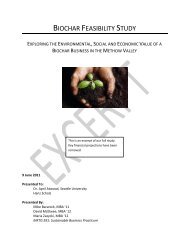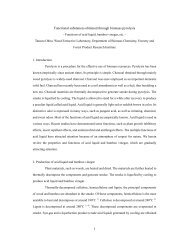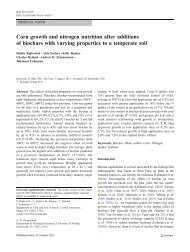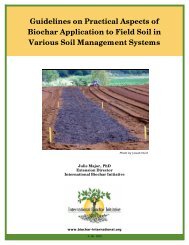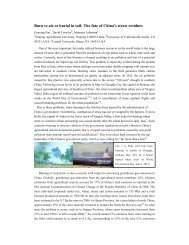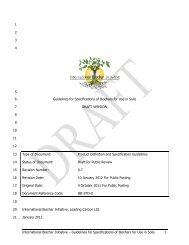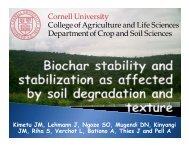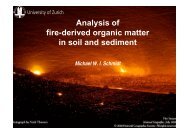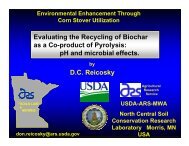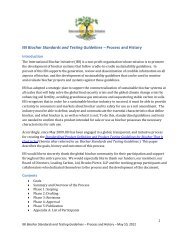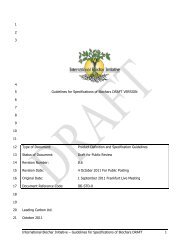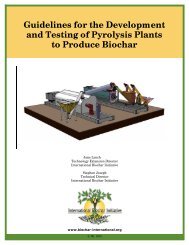Standardized Product Definition and Product Testing Guidelines for ...
Standardized Product Definition and Product Testing Guidelines for ...
Standardized Product Definition and Product Testing Guidelines for ...
Create successful ePaper yourself
Turn your PDF publications into a flip-book with our unique Google optimized e-Paper software.
1<br />
2<br />
3<br />
4<br />
5<br />
6<br />
7<br />
8<br />
9<br />
10<br />
11<br />
12<br />
13<br />
14<br />
15<br />
16<br />
17<br />
18<br />
19<br />
20<br />
21<br />
22<br />
23<br />
24<br />
25<br />
26<br />
27<br />
28<br />
29<br />
30<br />
31<br />
32<br />
33<br />
34<br />
35<br />
36<br />
37<br />
Appendix 2 – Recommended General Sample Analysis Procedures<br />
<strong>and</strong> Protocols <strong>for</strong> Specific Tests<br />
Biochar sampling<br />
Strict adherence to st<strong>and</strong>ardized biochar sampling procedures is critical to ensure reliable,<br />
representative, <strong>and</strong> replicable test results. Following accepted compost analysis practices, the<br />
Test Methods <strong>for</strong> the Examination of Composting <strong>and</strong> Composts (TMECC) (US Composting<br />
Council <strong>and</strong> US Department of Agriculture (2001)) has been identified as an effective general<br />
sampling procedure to comply with the Biochar <strong>Guidelines</strong>. The TMECC documents provide<br />
detailed descriptions of sampling procedures <strong>for</strong> piles of unsorted, potentially heterogeneous<br />
material, which result in homogeneous, representative samples to be used in subsequent<br />
chemical analysis (Section 02.01 Field Sampling of Compost Materials in US Composting Council<br />
<strong>and</strong> US Department of Agriculture (2001)). Adhering to TMECC sampling guidance will ensure<br />
consistency in analytical approach, since subsequent physicochemical analyses within the<br />
Biochar <strong>Guidelines</strong> document recommend the use of TMECC methodologies.<br />
Sample h<strong>and</strong>ling <strong>and</strong> processing<br />
Since sample h<strong>and</strong>ling <strong>and</strong> processing is analysis-methodology-dependent, appropriate<br />
procedures should be selected based upon the chemical tests that will be conducted. Sample<br />
processing can vary depending upon the physicochemical analyses to be conducted; sample<br />
preparation methods followed should be specifically intended <strong>for</strong> the selected physicochemical<br />
tests to be conducted. For example, sample preparation methods can include grinding <strong>and</strong><br />
sieving or oven-drying <strong>for</strong> analysis, to provide the dry weight measure indicated in Table 3 of<br />
the biochar test categories. General sample preparation procedures can be found in TMECC<br />
Section 02.02 Laboratory Sample Preparation in US Composting Council <strong>and</strong> US Department of<br />
Agriculture (2001). Caution should be exercised however, since the methodologies<br />
recommended therein are designed <strong>for</strong> compost, <strong>and</strong> not <strong>for</strong> biochar. Comments within the<br />
TMECC document (US Composting Council <strong>and</strong> US Department of Agriculture (2001)) indicate<br />
that sample heating can occur while grinding, which can result in a change in sample qualities<br />
<strong>and</strong> characteristics. To avoid this, it is recommended that samples to be ground <strong>and</strong> sieved to a<br />
smaller size range (e.g. 2mm) be h<strong>and</strong>-ground in a mortar <strong>and</strong> pestle, to reduce the risk of<br />
heating, sparking, or ignition (following sample grinding methods <strong>for</strong> pH <strong>and</strong> EC assessment<br />
noted in Rajkovich et al, 2011).<br />
Combined approach to analyzing pH <strong>and</strong> EC<br />
Generic pH <strong>and</strong> EC analysis procedures have been drawn from the TMECC methodologies (US<br />
Composting Council <strong>and</strong> US Department of Agriculture (2001)). These procedures <strong>for</strong> the use of<br />
<strong>St<strong>and</strong>ardized</strong> <strong>Product</strong> <strong>Definition</strong> <strong>and</strong> <strong>Product</strong> <strong>Testing</strong> <strong>Guidelines</strong> <strong>for</strong> Biochar That Is Used in Soil 24



